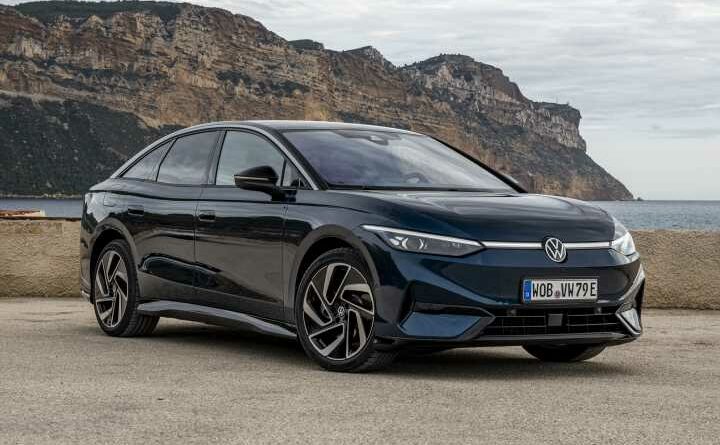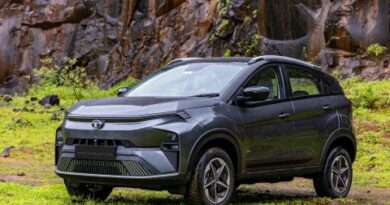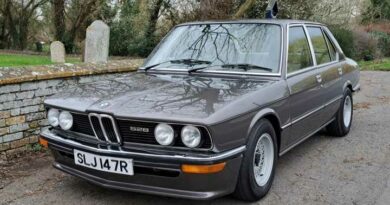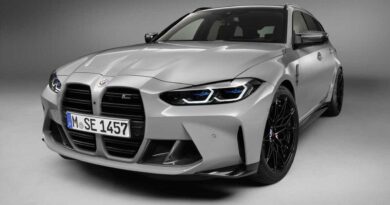2024 Volkswagen ID.7 | PH Review
Flagship rear-drive EV offers plenty of space, limited pace
By Mike Duff / Monday, 13 November 2023 / Loading comments
Unlikely as it seems the concept of the flagship saloon – a term that gets anyone of a certain age thinking of Vauxhall Senators and Rover 800s – is lasting into the electric age. Because that is, pretty much what the Volkswagen ID.7 is – the largest, grandest and most expensive of VW’s growing clan of EVs.
Okay, not quite – the ID.7’s rear glass lifts along with its tailgate, meaning it is technically a hatchback. But the three-box design and sizeable dimensions, being nearly five metres long and 95mm bigger than the Arteon, clearly indicate its position at the top of the tree. Nor is VW unique in having such thoughts, the Hyundai Ioniq 6 and Lexus LF-ZC that were previewed at last month’s Tokyo motor show give welcome proof the future isn’t exclusively SUV-shaped.
In Volkswagen’s case the new direction is being driven by aerodynamics as much as design purity. Being lower and sleeker makes the ID.7’s passage through the air easier, and the number the engineering team seem keenest to boast about is the very slippery 0.23 drag coefficient. That’s a large part of the reason Volkswagen is able to claim an impressive 384 miles of WLTP range for the rear-driven ID.7 with the 77kWh battery – with the prospect of a brawnier 86kWh version to follow which will have around 420 miles of Euro-range.
You will probably have realised that putting range and battery capacity above performance in the story is a clear indication of where the launch-spec ID.7’s priorities lie – because this is definitely not one of those supercar-crushing EV powerhouses. The rear-drive version uses a single motor at the rear, VW’s more potent new AP550 unit, with this delivering peaks of 282hp and 401lb ft of torque. Working against a chunky 2,172kg this results in performance that is towards the blunt end of the segment.
Like most EVs, the ID.7 feels impressively brisk when launched hard, and the lack of any gearchange punctuation means that speed builds without delay. But although the 6.5-second 0-62mph time feels subjectively right, acceleration tails off quickly as the speed gets much past this. It would certainly take a long straight and lots of patience to confirm the presence of the 112mph speed limiter, and while the ID.7 stayed impressively quiet when cruising at a semi-brave Autoroute pace on the French test route, it is definitely no rocket ship. There will also be an all-wheel-driven version, but we will have to wait for power, performance and price information on that one.
Even in base form, the ID.7’s handling is pretty good. EVs aside, it’s a long time since Volkswagen created any rear-driven car, but the company’s engineers still clearly understand the principles. As in the company’s lesser ‘leccy offerings the steering has an artificial weight in lieu of any actual feedback, but it delivers proportionate front-end responses and the ID.7 feels stable when asked to change direction at higher speeds.
Slower, tighter corners make the ID.7’s weight obvious, but there is plenty of grip and although this unsurprisingly tends to fade to understeer, it is possible to influence the rear axle’s attitude with the accelerator. Nannyish stability control stops anything as exciting as power sliding, but the cornering line can be tightened or slackened progressively and the ID.7 has a lightness to its responses which suits it well.
The car I drove on the launch had the DCC adaptive dampers which will likely be an option rather than standard fitment. As in the Golf, these offer no fewer than 15 separate stiffness settings in the Individual dynamic settings, from what felt a little like ‘70s Cadillac at one end to concrete dampers at the other. Regardless of the setting chosen, the dampers rapidly adapt to rougher surfaces or big chassis inputs – and sticking to the middle of the range, or using the regular Comfort or Sport modes, body control and comfort were both excellent.
Not that, despite that, the ID.7’s cabin feels particularly luxurious. The sparseness of the ID.3, ID.4 and ID.5 has been carried forwards with minimal switchgear and most functions are managed by touch-sensitive steering wheel panels and the central touchscreen. The ID.7 even persists with the cheaper cars’ irritating electric window switches on the driver’s door – there is a separate one for each side, but operating a back window requires a ‘REAR’ panel to be selected first. It’s a bit of penny-pinching that felt stingy in the base ID.3, and which feels positively Scrooge-like in what will be, in its cheapest form, a £55,570 car.
The ID.7’s position at the top of the clan earns it some plusher materials, leatherette dash panels, Alcantara seats and LED-backlit trim panels with tweakable colours. But there are still lots of dark, hard-feeling plastics lower down in the cabin, and the tiny instrument screen ahead of the driver – relaying just speed, charge and warning icons, looks like it belongs in something far cheaper. There is generous space front and rear – a six-footer could sit behind another without either needing to compromise on legroom – plus the option of an adaptive glass roof which can be electrically switched from clear to opaque.
Volkswagen spent lots of time pushing the advantages of the improved UI system, which now plays on the ID.7’s XL 15-inch touchscreen, but I was distinctly underwhelmed by it. The screen itself looks great, and now features a row of shortcut icons at the top to make it easier to move between different functions – plus an always-there climate band at the bottom so that turning on the seat heating is no longer an awkward three-stage hunt-and-peck. Heating and ventilation as well as audio functions are still controlled by an irritating touch-screen ledge beneath the screen, making it easy to give unintended inputs.
The supposedly smartened IDA voice assistant was still pretty dumb. IDA can now respond to prompts like “my hands are cold” – which turns on the steering wheel heating – and can list local restaurant options including menus. But it frequently activated without anything close to the “hello IDA” or “hello Volkswagen” trigger phrases being uttered, with a generally inept transcription of whatever was being said in the car then scrolling across the main screen.
The similarly enhanced ‘Travel Assist’ smart cruise control also had issues. This now incorporates an active speed management system that will automatically adjust velocity as limits change (yes, we’ve arrived at that particularly Dystopia). This managed most transitions cleanly, but struggled with the lower Autoroute wet conditions limit, sticking to what had become an illegal 130km/h even as the rain started to fall heavily. There is also a new active lane change function which supposedly allows the ID.7 to pass slower-moving traffic on a multi-lane highway; all the driver needs to do is indicate to order the transition. Again, this was more miss than hit, sometimes working as intended and sometimes completely refusing to, braking to sit behind the slower-moving vehicle with its indicator flashing, even when the road behind was completely clear.
At least one of the new smart systems worked seamlessly – the new augmented reality display. This is basically an XL head-up display able to project onto a much bigger part of the windscreen, meaning that it can show which way to go at a junction by applying a big arrow, or even showing which lane to be in well ahead of an Autoroute split. It’s a neat idea which worked well when asked to deal with the challenge of inner-city Marseilles.
Like many modern EVs, the ID.7 feels like a car that drivers aren’t supposed to operate unless they have to. One that, in its default state, will sprinkle every journey with copious warnings about speed limits and wheel-nudging lane-keep prompts. Which is a shame, because the basics of chassis and controls are actually far slicker than the intrusive active systems that sit on top of them. There is a genuinely talented car under all the slap, but I suspect relatively few people will ever get the chance to realise that.
Specification | Volkswagen ID.7
Engine: Electric motor, rear-wheel drive
Gearbox: Single-speed reduction, rear-wheel drive
Power: 282hp
Torque: 401lb ft
0-60mph: 6.5 seconds
Top speed: 112mph (limited)
Kerbweight: 2172kg
MPG: TBC
CO2 emissions: 0g/km
Price: £55,750 (Base price)
- 2023 VW ID Buzz Style | UK Review
- 2023 Volkswagen Amarok V6 | UK Review
Source: Read Full Article



